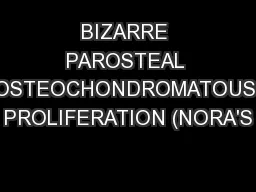PPT-BIZARRE PAROSTEAL OSTEOCHONDROMATOUS PROLIFERATION (NORA'S
Author : celsa-spraggs | Published Date : 2015-10-27
J BEN NASR M CHELLI BOUAZIZ W TURKI L ABID MH JAAFOURA MF LADEB MUSCULOSKELETAL MK 24 INTRODUCTION Bizarre parosteal osteochondromatous proliferation BPOP
Presentation Embed Code
Download Presentation
Download Presentation The PPT/PDF document "BIZARRE PAROSTEAL OSTEOCHONDROMATOUS PRO..." is the property of its rightful owner. Permission is granted to download and print the materials on this website for personal, non-commercial use only, and to display it on your personal computer provided you do not modify the materials and that you retain all copyright notices contained in the materials. By downloading content from our website, you accept the terms of this agreement.
BIZARRE PAROSTEAL OSTEOCHONDROMATOUS PROLIFERATION (NORA'S: Transcript
Download Rules Of Document
"BIZARRE PAROSTEAL OSTEOCHONDROMATOUS PROLIFERATION (NORA'S"The content belongs to its owner. You may download and print it for personal use, without modification, and keep all copyright notices. By downloading, you agree to these terms.
Related Documents














